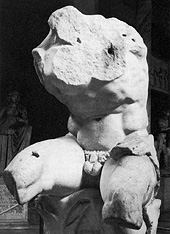After receiving his initial training as an architect, Constantin Hansen transferred in 1825 to the Academy in Copenhagen and into the class of the painter Christoffer Eckersberg (1783-1853), whose colouristic-realistic painting style he assumed. In 1835, he received a state scholarship for a study visit to Rome, which enabled him to stay in Italy for four formative years. After his return, Hansen made a mark – not only in Denmark – as one of the most important artists of northern European classicism.
The Belvedere Torso, named after its location in the Vatican’s Belvedere Courtyard, survives today as a fragmentary copy from the 1st century BCE of an even older sculpture (Fig.1). The statue was mentioned for the first time in 1430 as being in Cardinal Prospero Colonna’s collection in Rome, and then only briefly with the sculptor Andrea Bregno. The statue was probably damaged in the Palazzo Colonna during the Sack of Rome in 1527. Only a few decades later, the Torso was installed in the Vatican, where, through its proximity to the Apollo Belvedere and other Roman archaeological finds, it soon garnered enormous fame and continuously inspired great artists from the Renaissance onward. In 1798, the Torso arrived in Paris as part of the Napoleonic art booty, where it likewise inspired great admiration. Only in 1816 was it able to be reintegrated into the Vatican collections.

